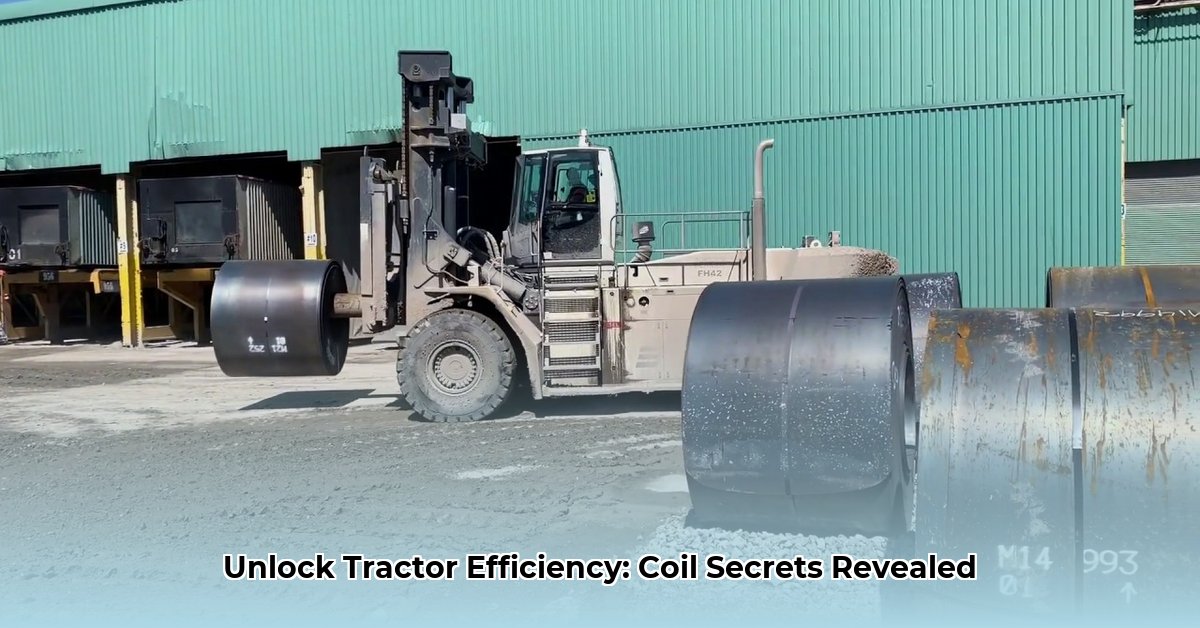
Farm work demands optimal tractor performance. A faulty ignition coil can lead to costly downtime. This guide provides a comprehensive, step-by-step approach to selecting and installing the correct replacement coil, ensuring your tractor runs smoothly. We'll cover coil fundamentals, compare different coil types, and offer detailed installation and troubleshooting instructions. For additional tractor maintenance tips, check out our guide on tractor attachments.
Understanding Tractor Ignition Coils
The ignition coil is a vital component in your tractor's ignition system. It transforms low-voltage battery power into the high-voltage spark required to ignite the fuel-air mixture in the engine's cylinders. Without a properly functioning coil, your tractor won't start. Think of it as a miniature, high-powered transformer.
Several key terms define coil characteristics:
- Voltage (kV): The electrical pressure; higher voltage generally equates to a stronger spark (e.g., a 40kV coil delivers a more powerful spark than a 30kV coil).
- Resistance (ohms): A measure of how much the coil resists the flow of electricity; lower resistance often translates to more efficient spark delivery.
- Fill Type: Coils can be oil-filled or epoxy-filled. Epoxy-filled coils are generally more robust and better withstand high temperatures, offering better reliability in challenging conditions.
- Mounting Configuration: Coils have various mounting styles (vertical or horizontal); selecting the correct configuration is crucial for proper installation.
Ignition Coil Types: A Comparative Analysis
Choosing a replacement coil involves considering several options:
OEM (Original Equipment Manufacturer): These coils are manufactured by the tractor's original manufacturer, guaranteeing a perfect fit and reliable performance. However, OEM coils are often expensive and may be difficult to find for older tractors. The guaranteed compatibility offsets the higher price.
Aftermarket Coils: A wide variety of aftermarket coils exist, offering more affordable alternatives to OEM parts. Quality varies significantly between manufacturers. Meticulous research is crucial to ensure you get a reliable, high-quality replacement that meets your tractor's needs. Thorough research and checking reviews are therefore essential.
High-Performance Coils: Designed for enhanced spark output, these coils can improve engine efficiency and power. They usually come at a premium price and might require adjustments to your tractor's system for optimal performance. Increased spark energy leads to more complete combustion.
The following table provides a simplified comparison (specific values vary based on the manufacturer and tractor model):
| Coil Type | Voltage (kV) | Resistance (ohms) | Price Range | Availability | Pros | Cons |
|---|---|---|---|---|---|---|
| OEM | Varies | Varies | High | Often Limited | Guaranteed compatibility, reliable performance | High cost, sometimes difficult to find |
| Aftermarket Standard | Varies | Varies | Moderate | Widely Available | Cost-effective, generally reliable | Performance might not exactly match OEM |
| High-Performance | 40+ | Often lower | High | Variable | Increased power and efficiency potential | May require adjustments, higher price |
Note: These figures are approximate. Always consult your tractor's manual and the coil's specifications for precise values.
Choosing the Correct Ignition Coil: A Step-by-Step Guide
Selecting the wrong coil can lead to engine problems. Follow these steps to ensure a perfect fit:
Identify Your Tractor: Note the make, model, year, and engine type. This information is usually found on a sticker or plate on the tractor.
Locate the OEM Part Number: Your owner's manual should list the correct part number for your tractor's ignition coil. This is your starting point guaranteeing a perfect, original specification match.
Cross-Reference Part Numbers: Use the OEM part number to search online parts catalogs or consult your local agricultural supply store. This helps find compatible OEM or aftermarket replacements.
Verify Specifications: Ensure the voltage, resistance, and mounting configuration match your tractor's original coil. Discrepancies might damage your engine.
Compare Options: Consider your budget and desired performance level when evaluating OEM, aftermarket, and high-performance options.
Check Reviews: Before purchasing, check online reviews to learn from other tractor owners' experiences with potential replacement coils.
Installing Your New Ignition Coil: A Safety-First Approach
Safety precautions are crucial. Always disconnect the negative battery terminal before working on the tractor's electrical system.
Remove the Old Coil: Carefully detach any fasteners holding the old coil in place. Take photos or notes to help with reassembly. Proper documentation reduces the risk of mistakes.
Inspect the Mounting: Carefully observe the old coil's mounting orientation (vertical or horizontal). The new coil must be mounted identically.
Install the New Coil: Securely attach the new coil, ensuring its correct orientation.
Reconnect the Wiring: Connect the wires to the new coil, following the original wiring diagram.
Reconnect the Battery: After verifying all connections, reconnect the battery's negative terminal.
Maintenance and Troubleshooting
Regular inspection can prolong the life of your ignition coil.
Visual Inspection: Regularly check the coil for cracks, damage, or corrosion. Early detection prevents catastrophic failure.
Weak or No Spark: Check wire connections first; loose or corroded connections are common causes. If the problem persists, the coil may require replacement.
Intermittent Issues: Loose connections or problems with the high-tension wires may be responsible.
If you lack electrical system expertise, consult a qualified mechanic.
Conclusion: Ensuring Reliable Tractor Operation
Choosing and installing the correct ignition coil is crucial for maintaining optimal tractor performance and minimizing downtime. This guide offers a roadmap to facilitate this process. Always prioritize safety and consult your tractor's manual for detailed instructions. Remember, proactive maintenance contributes significantly to a longer lifespan of your tractor's ignition system.